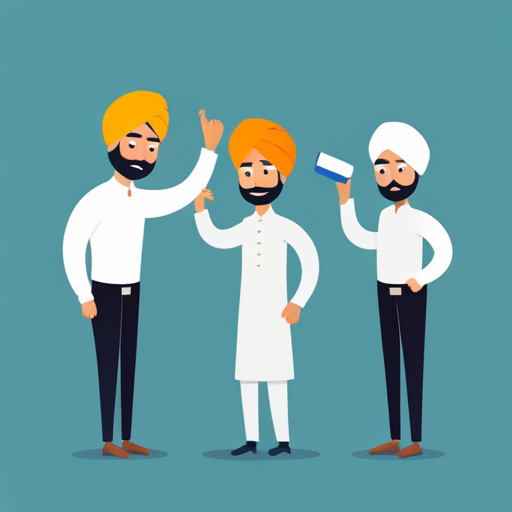Identity Crisis Episode: AADHAR Authentication's Comedy of Errors with Fickle Fingerprints.
Navigating the Hilarious Quagmire of AADHAR Authentication: Flaky Fingerprints, Funky Frauds, and the Perplexing Dance of Left and Right Thumbs.
My KYC Experience: Recently, my bank insisted on conducting my KYC verification using the latest AADHAR authentication system, complete with the use of biometrics—specifically, fingerprints. Despite being a loyal customer for over two decades, where I have waltzed in and out of their branch like a familiar face, I welcomed two delightful executives into my humble abode, assuming that this process would be a breeze. Little did I know that this seemingly routine encounter would quickly spiral into a series of comical mishaps, making me question the very nature of this adventure in biometric chaos1.
Fingerprint Authentication Failure: To my horror, my initial attempt at verification failed miserably. My right hand's thumb, forefinger, and middle finger—sequentially—were all deemed unworthy by the system. Panic set in. Was I the victim of an audacious fraud? Had my fingerprints been tampered with? Could my very identity have been pilfered? Or worse, would I now be declared a fraudulent imposter? Perhaps, the government machinery would even proclaim that I cease to exist—a living, breathing ghost without an AADHAR, a person without a foundation.
Retina Scan? In a desperate bid to salvage the situation, I beseeched the dynamic duo to scan my eye's retina instead. Alas, their handheld gadget was ill-equipped for such a task. As they reassured me that fingerprints do change over time, my mind swirled with a medley of worries. Nevertheless, I dismissed the possibility of someone hacking into the impregnable UIDAI database, having personally witnessed the persuasive arguments of a brilliant IIT Mumbai graduate, my Maharashtra cadre IAS batchmate2, who had very articulately and authoritatively presented the case before the Supreme Court of India3.
Had my PS “signed”? But my apprehensions took an unexpected turn. I wondered whether, back in 2013, when I first registered for AADHAR while on central deputation, had my Private Secretary quietly opted to "digitally" sign on my behalf using her fingerprints? After all, in the bustling realm of Delhi, they sign "for" their bosses all the time. I also realized that subsequently, I had merely authenticated my AADHAR using a simple OTP on my mobile, never having gone through the rigours of the biometric route.
Had used it office attendance: However, a glimmer of relief illuminated my troubled mind. When the Modi Government came into power in May 2014, AADHAR authentication had became a prerequisite for office attendance—a “Digital India” (pun intended) crusade, if you will. Even the "Big Babus" were not exempt, though those of the Joint Secretary rank and above were granted the honour of having a dedicated device installed at their office desks. Hence, I had regularly validated my presence by imprinting my Right Thumb Impression (RTI)—a unique twist on digital accountability.
All’s well that ends well: Finally, my panic subsided as the executive suggested trying my left hand thumb. Lo and behold, it worked like a charm! Both the duo and I heaved a sigh of relief, exclaiming, "Baayein haath ka khel!" (बाएँ हाथ का खेल। A trick of the left hand). I was verified, vindicated, and vouched for. Yet, it struck me that this glitch was far from the flawless experience we were promised from the AADHAR system. After all, the cream of the crop—India's top techies and bureaucrats—had assured us of its infallibility.
Serious lesson underneath: In this lighthearted anecdote, we find humour in the quirks and foibles of technology. However, as we embrace the convenience and efficiency of AADHAR, let us remember that even in the midst of laughter, we mustn't forget the importance of safeguarding our digital identities4.
The author AI-generated the pics using “DreamStudio”.
Dr Ajay Bhushan Prasad Pandey, IAS (MH: 1984) was then the CEO of UIDAI. He was later elevated as Revenue Secretary, GOI, before retiring in February, 2021
Supreme Court strengthens the shaky AADHAAR foundation.
Strikes proper balance between “privacy concerns” and issues of “targeted subsidies” The Supreme Court on 26th September, 2018 pronounced, by 4–1 majority, its verdict upholding the constitutional validity of the Aadhaar Act as well as the general schema supporting the issuance of Aadhaar cards…
Don't Fall Prey to Cyber-Fraud in the Age of Internet Payments
Introduction: In today's technologically advanced world, financial transactions have undergone a significant transformation, presenting new challenges for everyone, especially the senior citizens, in in relation to cyber fraud. I recently found myself in a precarious situation when a cunning cybercriminal attempted to exploit my trust and deprive me of …





